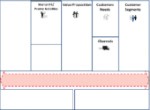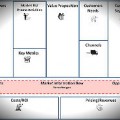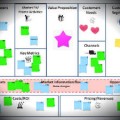In the previous post I went over what the Minimum Viable Product marketing (MVP) plan can do for your company. Now, I will share with you the elements that are part of the MVP marketing plan.
The MVP marketing plan takes its inspiration from the Business Model Generation (BMG) canvas as well as Lean Startup methodology. It uses the canvas form of the BMG and shares some of the same elements. It is also used the same way with little sticky notes (texts or pictograms) to remind you of what you discussed with your team.
Each iteration of your MVP will require adjustments to your MVP marketing plan. Of course, the first one will be the longest to build as you will be starting from scratch.
Value Proposition
Your value proposition is defined as the benefits your customers can expect from your product or service. It is the heart of your marketing plan. Your value proposition will state how your customers will maximise their gains, minimise their pains and do their jobs (literally or figuratively) better with your product or service. Writing your value proposition is not always an easy task. If you are having a hard time with it I strongly suggest you take a look at Value Proposition Design from the authors of BMG.
Identifying the customers’ needs, you are answering with your MVP, is essential to writing your value proposition. It is also normal and positive to refine your understanding of your customer needs from one plan iteration to the next. Your new findings will most likely impact most if not all of the other elements of the plan. This previous Techno Marketing blog post on understanding your customer needs can help.
![]() Customer Segments
Customer Segments
Your MVP marketing plan may be addressing one, a few, or all of your customer segments. The assumption here is that you have already identified the segments your business will be pursuing. Customer segmentation can be just as difficult, if not more, than writing your value proposition. There are hundreds if not thousands of marketing books that will try to teach you how to go about segmentation. Taken to its limits it is a science. However, if you are just starting up and marketing isn’t your thing, here is a little recipe that will help you get started with your segmentation. When you go out and talk to people, you assume will be interested by your product or service, put them into 3 groups:
- Super excited about your product and want to buy it right now
- Are interested in your product and want more information
- Listened to you politely, told you your idea was great and wished you luck
Discard the folks in groups 2 and 3 as well as the ones who told you to go fly a kite for this exercise. Analyse all the information you wrote down as well as the one you remember from your meetings with people in group 1. You will need at least 5-6 subjects in group 1 in order to segment (*). Try to find commonalities among a few of the subjects or characteristics that differentiate them from each other. The commonalities or characteristics could be
- How important certain of the pains you are trying to ease are to them
- How much value they place on the gains your product offers them
- How they go about doing the job you want to facilitate on a daily basis
Just remember you will be forming segments with these variables in the future. Hence you want them to be as easily measurable and identifiable as possible.
 Market fit and/or promotional activities
Market fit and/or promotional activities
This element of the plan includes different types of activities. If you are ready to start selling your product (even in pre-order mode) you will need to promote your company and product to do so. Your ‘’marketing team’’ will think of some promotional activities for each segment and this element is where you will keep track of what is going on at a given time. If you are not yet selling but you are either promoting your brand (maybe with potential VCs), elaborating a Kickstarter campaign, or doing some other promotional activity to get your product or product idea out in front of potential customers, this is also where you will keep track of those activities.
![]() Channels
Channels
This element identifies the distribution channels that will be impacted by your promotional activities. Whether it be the web, your sales reps or point of sales this element will help you keep track of who and how they will be impacted as well as any actions required with the channels due to your promotional activities.
The third post in this series will cover the five remaining elements of the MVP marketing plan.
(*) If you don’t have at least 5 persons in group 1, try with people that have a different profile or get someone who can communicate the value proposition better. If you have looked high and low and can’t find 5 persons excited about your product, abandon ship and try again with a different product/service idea.
EDIT – Sept. 2016 – Graphics






 Customers Needs
Customers Needs




